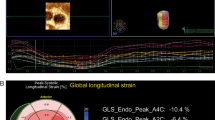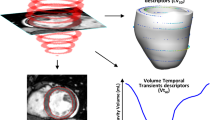Abstract
Objectives
The aim of this cross-sectional study was to investigate the association of left atrial (LA) strain parameters with demographics, clinical data, cardiovascular magnetic resonance (CMR) findings, and cardiac complications (heart failure and arrhythmias) in a cohort of patients with β-thalassemia major (β-TM).
Materials and methods
We considered 264 β-TM patients (133 females, 36.79 ± 11.95 years) consecutively enrolled in the Extension-Myocardial Iron Overload in Thalassemia (E-MIOT) project. Moreover, we included 35 sex- and age-matched healthy controls (14 females, mean age 37.36 ± 17.52 years). Reservoir, conduit, and booster LA functions were analysed by CMR feature tracking using dedicated software.
Results
Compared to the healthy control group, β-TM patients demonstrated lower LA reservoir strain and booster strains, as well as LA reservoir and booster strain rates. However, no differences were found in LA conduit deformation parameters. In β-TM patients, ageing, sex, and left ventricle (LV) volume indexes were independent determinants of LA strain parameters. The number of segments with late gadolinium enhancement (LGE) significantly correlated with all LA strain parameters, with the exception of the LA conduit rate. Patients with cardiac complications exhibited significantly impaired strain parameters compared to patients without cardiac complications.
Conclusion
In patients with β-TM, LA strain parameters were impaired compared to control subjects, and they exhibited a significant correlation with the number of LV segments with LGE. Furthermore, patients with cardiac complications had impaired left atrial strain parameters.
Clinical relevance statement
In patients with β-thalassemia major, left atrial strain parameters were impaired compared to control subjects and emerged as a sensitive marker of cardiac complications, stronger than cardiac iron levels.
Key Points
• Compared to healthy subjects, β-thalassemia major patients demonstrated significantly lower left atrial reservoir strain and booster strains, as well as left atrial reservoir and booster strain rates.
• In β-thalassemia major, ageing, sex, and left ventricular volume indexes were independent determinants of left atrial strain parameters, while left atrial strain parameters were not correlated with myocardial iron overload.
• An independent association between reduced left atrial strain parameters and a history of cardiac complications was found in β-thalassemia major patients.



Similar content being viewed by others
Abbreviations
- ANCOVA:
-
Analysis of covariance
- AUC:
-
Area under the curve
- CI:
-
Confidence interval
- CMR:
-
Cardiovascular magnetic resonance
- E-MIOT:
-
Extension-Myocardial Iron Overload in Thalassemia
- HF:
-
Heart failure
- LA:
-
Left atrium
- LGE:
-
Late gadolinium enhancement
- LV:
-
Left ventricular
- MIO:
-
Myocardial iron overload
- ROC:
-
Receiver operating characteristic
- RV:
-
Right ventricular
- SR:
-
Strain rate
- β-TM:
-
Beta-thalassemia major
References
Cao A, Galanello R (2010) Beta-thalassemia. Genet Med 12:61–76
Weatherall DJ (2010) Thalassemia as a global health problem: recent progress toward its control in the developing countries. Ann N Y Acad Sci 1202:17–23
Shander A, Cappellini MD, Goodnough LT (2009) Iron overload and toxicity: the hidden risk of multiple blood transfusions. Vox Sang 97:185–197
Borgna-Pignatti C, Rugolotto S, De Stefano P et al (2004) Survival and complications in patients with thalassemia major treated with transfusion and deferoxamine. Haematologica 89:1187–1193
Akiki N, Hodroj MH, Bou-Fakhredin R, Matli K, Taher AT (2023) Cardiovascular complications in β-thalassemia: getting to the heart of it. Thalassemia Rep 13:38–50
Pepe A, Pistoia L, Gamberini MR et al (2022) National networking in rare diseases and reduction of cardiac burden in thalassemia major. Eur Heart J 43:2482–2492
Kremastinos DT (2001) Heart failure in β-thalassemia. Congest Heart Fail 7:312–314
Anderson LJ, Holden S, Davis B et al (2001) Cardiovascular T2-star (T2*) magnetic resonance for the early diagnosis of myocardial iron overload. Eur Heart J 22:2171–2179
Chinprateep B, Ratanasit N, Kaolawanich Y et al (2019) Prevalence of left ventricular diastolic dysfunction by cardiac magnetic resonance imaging in thalassemia major patients with normal left ventricular systolic function. BMC Cardiovasc Disord 19:245
Nagueh SF, Khan SU (2023) Left atrial strain for assessment of left ventricular diastolic function: focus on populations with normal LVEF. JACC Cardiovasc Imag 16:691–707
Cau R, Bassareo P, Suri JS, Pontone G, Saba L (2022) The emerging role of atrial strain assessed by cardiac MRI in different cardiovascular settings: an up-to-date review. Eur Radiol 32:4384–4394
Cau R, Bassareo P, Caredda G, Suri JS, Esposito A, Saba L (2022) Atrial strain by feature-tracking cardiac magnetic resonance imaging in takotsubo cardiomyopathy. Features, feasibility, and reproducibility. Can Assoc Radiol J 73:573–580
Kostopoulou AG, Tsiapras DP, Chaidaroglou AS, De Giannis DE, Farmakis D, Kremastinos DT (2014) The pathophysiological relationship and clinical significance of left atrial function and left ventricular diastolic dysfunction in beta-thalassemia major. Am J Hematol 89:13–18
Li W, Coates T, Wood JC (2008) Atrial dysfunction as a marker of iron cardiotoxicity in thalassemia major. Haematologica 93:311–312
Inoue YY, Alissa A, Khurram IM et al (2015) Quantitative tissue-tracking cardiac magnetic resonance (CMR) of left atrial deformation and the risk of stroke in patients with atrial fibrillation. J Am Heart Assoc 4
Cau R, Bassareo P, Deidda M et al (2022) Could CMR tissue-tracking and parametric mapping distinguish between takotsubo syndrome and acute myocarditis? A pilot study. Acad Radiol 29(Suppl 4):S33–S39
Ramazzotti A, Pepe A, Positano V et al (2009) Multicenter validation of the magnetic resonance t2* technique for segmental and global quantification of myocardial iron. J Magn Reson Imaging 30:62–68
Meloni A, De Marchi D, Pistoia L et al (2019) Multicenter validation of the magnetic resonance T2* technique for quantification of pancreatic iron. Eur Radiol 29:2246–2252
Meloni A, Restaino G, Borsellino Z et al (2014) Different patterns of myocardial iron distribution by whole-heart T2* magnetic resonance as risk markers for heart complications in thalassemia major. Int J Cardio 177:1012–1019
Positano V, Pepe A, Santarelli MF et al (2007) Standardized T2* map of normal human heart in vivo to correct T2* segmental artefacts. NMR Biomed 20:578–590
Cerqueira MD, Weissman NJ, Dilsizian V et al (2002) Standardized myocardial segmentation and nomenclature for tomographic imaging of the heart: a statement for healthcare professionals from the Cardiac Imaging Committee of the Council on Clinical Cardiology of the American Heart Association. Circulation 105:539–542
Meloni A, Righi R, Missere M et al (2021) Biventricular reference values by body surface area, age, and gender in a large cohort of well-treated thalassemia major patients without heart damage using a multiparametric CMR approach. J Magn Reson Imaging 53:61–70
Zemrak F, Ambale-Venkatesh B, Captur G et al (2017) Left atrial structure in relationship to age, sex, ethnicity, and cardiovascular risk factors: MESA (Multi-Ethnic Study of Atherosclerosis). Circ Cardiovasc Imaging 10
Pepe A, Positano V, Capra M et al (2009) Myocardial scarring by delayed enhancement cardiovascular magnetic resonance in thalassaemia major. Heart 95:1688–1693
De Sanctis V, Soliman AT, Elsedfy H et al (2016) The ICET-A recommendations for the diagnosis and management of disturbances of glucose homeostasis in thalassemia major patients. Mediterr J Hematol Infect Dis 8:e2016058
McDonagh TA, Metra M, Adamo M et al (2021) 2021 ESC Guidelines for the diagnosis and treatment of acute and chronic heart failure. Eur Heart J 42:3599–3726
Buxton AE, Calkins H, Callans DJ et al (2006) ACC/AHA/HRS 2006 key data elements and definitions for electrophysiological studies and procedures: a report of the American College of Cardiology/American Heart Association Task Force on Clinical Data Standards (ACC/AHA/HRS Writing Committee to Develop Data Standards on Electrophysiology). Circulation 114:2534–2570
Cau R, Loewe C, Cherchi V et al (2022) Atrial impairment as a marker in discriminating between takotsubo and acute myocarditis using cardiac magnetic resonance. J Thorac Imaging 37:W78–W84
Patsourakos D, Aggeli C, Gatzoulis KA et al (2022) Left atrial deformation indices in beta-thalassemia major patients. Ann Hematol 101:1473–1483
Mancuso L, Vitrano A, Mancuso A, Sacco M, Ledda A, Maggio A (2018) Left ventricular diastolic dysfunction in beta-thalassemia major with heart failure. Hemoglobin 42:68–71
Abou R, Leung M, Tonsbeek AM et al (2017) Effect of aging on left atrial compliance and electromechanical properties in subjects without structural heart disease. Am J Cardiol 120:140–147
Nielsen AB, Skaarup KG, Hauser R et al (2021) Normal values and reference ranges for left atrial strain by speckle-tracking echocardiography: the Copenhagen City Heart Study. Eur Heart J Cardiovasc Imaging 23:42–51
Pitoulis FG, Terracciano CM (2020) Heart plasticity in response to pressure- and volume-overload: a review of findings in compensated and decompensated phenotypes. Front Physiol 11:92
Inoue K, Khan FH, Remme EW et al (2021) Determinants of left atrial reservoir and pump strain and use of atrial strain for evaluation of left ventricular filling pressure. Eur Heart J Cardiovasc Imaging 23:61–70
Gillebert TC (2020) Left atrial reservoir and booster function in HFrEF: implications for diastolic function. JACC Cardiovasc Imaging 13:1116–1118
Imai M, Ambale Venkatesh B, Samiei S et al (2014) Multi-ethnic study of atherosclerosis: association between left atrial function using tissue tracking from cine MR imaging and myocardial fibrosis. Radiology 273:703–713
Kowallick JT, Silva Vieira M, Kutty S et al (2017) Left atrial performance in the course of hypertrophic cardiomyopathy: relation to left ventricular hypertrophy and fibrosis. Invest Radiol 52:177–185
Cau R, Muscogiuri G, Pisu F et al (2023) Effect of late gadolinium enhancement on left atrial impairment in myocarditis patients. Eur Radiol. https://doi.org/10.1007/s00330-023-10176-3
Pepe A, Meloni A, Rossi G et al (2018) Prediction of cardiac complications for thalassemia major in the widespread cardiac magnetic resonance era: a prospective multicentre study by a multi-parametric approach. Eur Heart J Cardiovasc Imaging 19:299–309
Meloni A, Pistoia L, Gamberini MR et al (2023) Multi-parametric cardiac magnetic resonance for prediction of heart failure death in thalassemia major. Diagnostics (Basel) 13
Truong VT, Safdar KS, Kalra DK et al (2017) Cardiac magnetic resonance tissue tracking in right ventricle: feasibility and normal values. Magnetic Resonance Imaging 38:189–195
Sun BJ, Park JH, Lee M et al (2020) Normal reference values for left atrial strain and its determinants from a large Korean multicenter registry. J Cardiovasc Imaging 28:186–198
Meloni A, Martini N, Positano V et al (2021) Myocardial iron overload by cardiovascular magnetic resonance native segmental T1 mapping: a sensitive approach that correlates with cardiac complications. J Cardiovascular Magn Resonance 23:70
Acknowledgements
We would like to thank all the colleagues involved in the Extension-Myocardial Iron Overload in Thalassemia project (https://emiot.ftgm.it/). We thank all patients and healthy volunteers for their cooperation.
This project is carried out within the framework of the European Reference Network on Rare Haematological Diseases (ERN-EuroBloodNet)-Project ID No 101085717. ERN-EuroBloodNet is partly co-funded by the European Union within the framework of the Fourth EU Health Programme.
Funding
The E-MIOT project received ‘no-profit support’ from industrial sponsorships (Chiesi Farmaceutici S.p.A. and Bayer). The funders had no role in study design, data collection and analysis, decision to publish, or manuscript preparation.
Author information
Authors and Affiliations
Corresponding author
Ethics declarations
Guarantor
The scientific guarantor of this publication is Filippo Cademartiri.
Conflict of interest
The authors of this manuscript declare no relationships with any companies, whose products or services may be related to the subject matter of the article.
Statistics and biometry
One of the authors has significant statistical expertise.
Informed consent
Written informed consent was obtained from all subjects in this study.
Ethical approval
Institutional Review Board approval was obtained.
Study subjects or cohorts overlap
Some study subjects have been previously reported in other studies of the E-MIOT project evaluating iron overload.
Methodology
-
• retrospective
-
• cross-sectional study
-
• performed at one institution
Additional information
Publisher's Note
Springer Nature remains neutral with regard to jurisdictional claims in published maps and institutional affiliations.
Rights and permissions
Springer Nature or its licensor (e.g. a society or other partner) holds exclusive rights to this article under a publishing agreement with the author(s) or other rightsholder(s); author self-archiving of the accepted manuscript version of this article is solely governed by the terms of such publishing agreement and applicable law.
About this article
Cite this article
Meloni, A., Saba, L., Positano, V. et al. Left atrial strain in patients with β-thalassemia major: a cross-sectional CMR study. Eur Radiol (2024). https://doi.org/10.1007/s00330-024-10667-x
Received:
Revised:
Accepted:
Published:
DOI: https://doi.org/10.1007/s00330-024-10667-x




